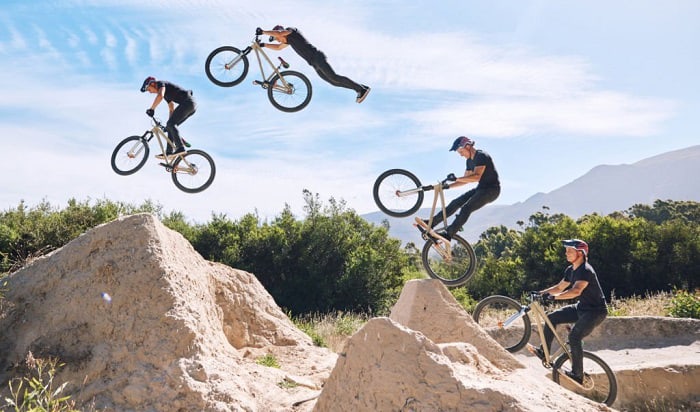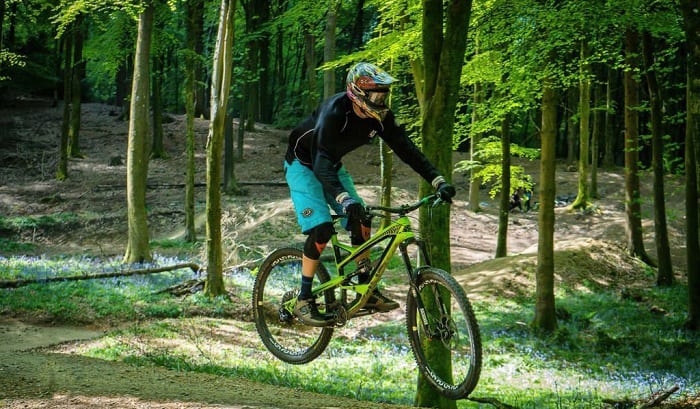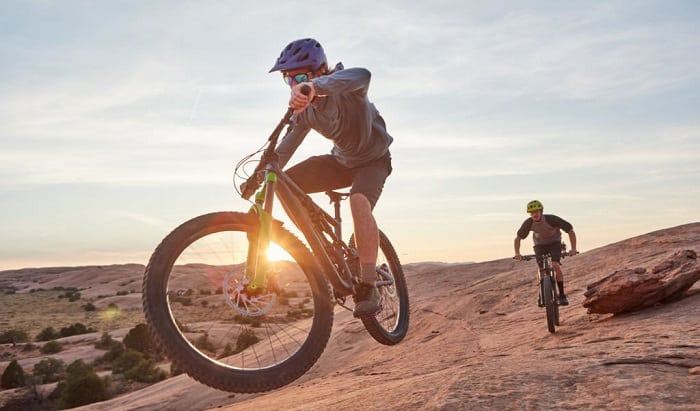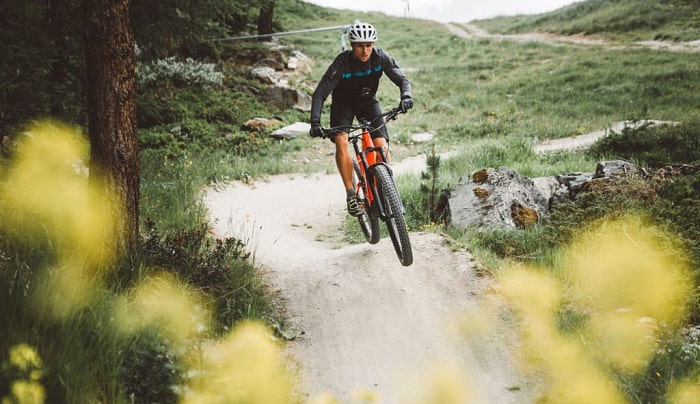MTB jumping is probably one of the most impressive stunts that anyone can pull off. There is a sense of thrill that you can only feel when seeing a mountain biker jumping while clearing a track quickly.
But how to jump on a mountain bike? Let’s take a look at the detailed steps that will allow us to pull off this stunt. We’ll also go over what we can do to develop the proper technique as well as some tips to get it right.
Keep reading to learn more.
Table of Contents
What You’ll Need
- Mountain bike (it should be in a good shape, so do a safety check first)
- Slope with tabletop landing (no gap)
- Jump ramp (optional)
Step-by-step Guide to Jump on a Mountain Bike
Before attempting to perform the jump, it is also a good idea to try watching a video that can help you visualize how to perform the whole thing.
In addition, review the jump tutorial with your whole body meaning you should go over the motions to get a better idea of how to shift your body during the stunt.
Step 1: Scouting a good spot
Find a spot that allows you to land on flat ground instead of a gap; this will help you concentrate on honing the skills you need for jumping on a mountain bike. You can jump gaps once you have the fundamentals down.
It’s also a good ideal to pre-plan your route, as it will help you spot any potential danger before attempting the jump. Generally, it’s best to start practicing your technique on artificial ramps.
Don’t forget to lower your saddle to avoid hurting yourself.
Step 2: Practicing the pumping technique
Approach the slope at a moderate speed and push downward as you near it. Once the front wheel touches the ramp’s lip, stop pedaling and shift your body weight to the pedals to bring force down onto the bike.
This pre-loading process will give your bike the additional power to perform the jump. You should also look out for your body position and leave enough clearance for your bicycle’s front to raise as you make the jump.
These are important and the most difficult thing would be getting your timing for them just right. Experiment by adjusting when to apply that push until you get it right.
Step 3: Taking off
As you start to elevate, you should pull up on your handlebars to help the bicycle’s front lift up.
At the same time, extend both of your legs as if standing up. This will allow your rear wheels to be in the correct position for the necessary burst. However, if you pull up on the bike too early, you won’t have enough push for a bicycle jump.
Your bike will be in an upright position with the front wheel raised and the slope should have given you enough lift to raise the bicycle well into the air.
Step 4: Air time and landing
Once in the air, it will be necessary to adjust your body just right. You need to straighten your arms and push the handlebar forward. At the same time, curl your legs with your butt sticking out back.
This combination of actions will bring both wheels to the same level, which means it is essential to check where you’ll land. One wheel hitting the ground earlier than the other may cause you to lose control, this is one of the most common jumping mistakes.
Another important point for landing is to ensure that your front wheel is directed to where you want to go. Even if you feel that the jump is a little off, directing the front will let you control where you are going.
Also, remember to return to your default position before you land.
Developing Jumping Technique
Learning to jump is not something you can do right away; you will have to put in enough time and effort. Nonetheless, it is something that anyone can do whether you’re young or over 40. Working on your biking fundamentals is a good start for beginners.
It is also recommended to learn other things before attempting to jump on a mountain bike; these include the Manual and the Bunny Hop. Both share certain similarities to jumping, but they are less difficult. Learning these will prepare you to jump better.
The Manual involves raising the front wheel of the bike. Among the first stunts to learn on a bicycle, Manual is for clearing obstacles and increasing your speed.
Studying the Manual technique first will give you a good idea of how to preload and lift your handlebars. It will also give you a better idea of how to shift your body while on the bike.
The Bunny Hop and Jump also share many similarities, and the only notable difference would be that we use a slope for the latter. Learning to Bunny Hop on mountain bike first will help you learn the fundamentals of getting the bicycle into the air properly.
The process of performing the Bunny Hop is very similar to jumping. Preload by applying downforce on the bike, pull up on your handlebars while shifting to a standing position, then level your bike wheels for the landing.
You’ll find that landing a jump won’t take as long if you’ve already got the Manual and the Bunny Hop down.
Why Jump – The Feeling and Practicality
There are different reasons why people jump on MTBs, but the most notable ones include the exhilaration and practicality purposes.
A 2013 study found that extreme sports allow people to experience a greater sense of freedom. Jumping in particular allows people to feel weightlessness, which is similar to flying—a symbol of freedom in literature and popular media.
There are also practical considerations for jumping as it allows bikers to clear obstacles faster and more efficiently, especially if they can control the height of their jumps.
Jumping does not require special equipment but it is recommended to have your safety gear, particularly your helmet. You’ll also find a pair of bike gloves handy as you practice to jump raps.
Getting to jump a hardtail mountain bike is not that different from other types, although you may find that certain models are easier to use; for example, a specialized dirt jump MTB designed specifically for air time.
For specific equipment recommendations, using bicycles with flat pedals is preferred. The main reason is that these allow you to jump off the bike when necessary and that you will be able to put your foot down faster resulting in being able to jump higher.
Conclusion
Now you know all about how to jump on a mountain bike, including the finer details such as how to shift your body during the stunt and other things to look out for. All that is left is to find good spots or jump ramps to use for your practice.
Have you tried to do a mountain bike jump yourself? How was your experience with it? Tell us all about it in the comments section below.
Always ride safely.

“I ride my bike to work for years, but is that enough? Our carelessness towards our surroundings has taken a toll on the environment. And now, everyone is responsible for changes; even the most minor contribution is counted. With this hope and spirit, I started with my partner to establish Biketoworkday to help more individuals commute to their work sites on their bikes.”




